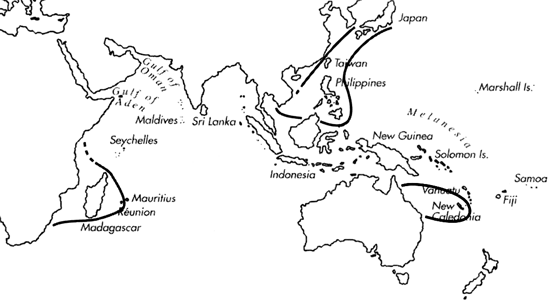
Skip Navigation Links
View access keys for this site.

Range: Japan to Philippines; Queensland (C. o. orbignyi); Natal to Madagascar and Réunion (C. o. elokismenos); New Caledonia and Coral Sea (C. o. coriolisi).
Description: Medium-sized in C. o. coriolisi, medium sized to large in C. o. orbignyi, to moderately large in C. o. elokismenos, light to moderately solid. Last whorl often pyriform, also narrowly conical or narrowly conoid- cylindrical in C. o. orbignyi (Pl. 56, Figs. 1-4), also conical or narrowly conical in C. o. coriolisi (Pl. 56, Fig. 7), and conical to ventricosely conical in C. o. elokismenos (Pl. 56, Figs. 5, 6); outline slightly convex at adapical two-thirds, concave to straight below. Siphonal canal often deflected to the dorsal side. Aperture very narrow. Shoulder angulate to sharply angulate, with weak tubercles often disappearing toward aperture in large specimens; exhalent notch rather deep. Spire high, stepped; outline straight to slightly concave. Larval shell of about 4 whorls, maximum diameter 0.85-1 mm. Postnuclear whorls tuberculate. Teleoconch sutural ramps slightly concave, with 0-1 increasing to 5-7 spiral grooves and with radial threads; in C. o. elokismenos spiral sculpture weaker on late ramps than in C. o. orbignyi. Entire last whorl with axially striate spiral grooves and ribbons between; 1-2 spiral ribs replacing ribbons just below shoulder. In C. o. orbignyi, spiral ribbons generally narrower and grooves wider than in C. o. elokismenos; some wide ribbons divided into pairs of narrow ribbons. In C. o. elokismenos, wide ribbons with spiral striae and surface sculpture weak on adapical fourth. In C. o. coriolisi, ribbons weak to obsolete adapically.
| Shell Morphometry | ||
|---|---|---|
| L | - | |
| RW | - | |
| RD | - | |
| PMD | - | |
| RSH | - | |
Ground colour white. Last whorl with rectangular brown spots on ribbons, aligned axially and also clustering in 3 spiral bands, below shoulder and on both sides of centre. In C. o. elokismenos, spots of adapical band variably fused into axial streaks. In C. o. coriolisi, pattern reduced to 3 interrupted bands. Larval whorls white to pale brown, often with a brown sutural line. Postnuclear sutural ramps with irregular brown streaks and brown spots at outer margin, often between tubercles. Aperture white, dark cream deep within.
Periostracum brownish grey, thin, translucent, smooth.
In C. o. elokismenos, animal pale yellow, siphon and sides of foot speckled with blackish brown. Operculum absent.
Radular teeth with an adapical barb opposite a second barb, and an additional posterior barb; base with distinct spur (Kilburn, 1973).
Habitat and Habits: C. o. orbignyi in 50-400 m; C. o. elokismenos in 270-310 m in mud (Kilburn, 1973); C. o. coriolisi in 150-550 m (Richard, pers. comm., 1991).
Discussion: C. orbignyi is very similar to C. pseudorbignyi, C. ichinoseana and C. comatosa. For the distinction, see the Discussions of those species. C. planicostatus is considered a synonym of C. orbignyi, although Sowerby's figure (Pl. 56, Fig. 8) has a relatively lower spire (RSH 0.21); all other shell characters suggest identity with C. orbignyi. C. orbignyi has a discontinuous range. There appear to be 3 disjunct groups of populations, in the western Pacific and in the western Indian Ocean. They are generally considered geographic subspecies, C. o. orbignyi in the W. Pacific, C. o. coriolisi in the New Caledonia-Coral Sea area, and C. o. elokismenos in the Indian Ocean.

C. orbignyi range map
This section contains verbatim reproductions of the accounts of 316 species of Conus from the Indo-Pacific region, from Manual of the Living Conidae, by Röckel, Korn and Kohn (1995). They are reproduced with the kind permission of the present publisher, Conchbooks.
All plates and figures referred to in the text are also in Röckel, Korn & Kohn, 1995. Manual of the Living Conidae Vol. 1: Indo-Pacific Region.
The range maps have been modified so that each species account has it own map, rather than one map that showed the ranges of several species in the original work. This was necessary because each species account is on a separate page on the website and not confined to the order of accounts in the book.
Return to framed version (returns to search page)